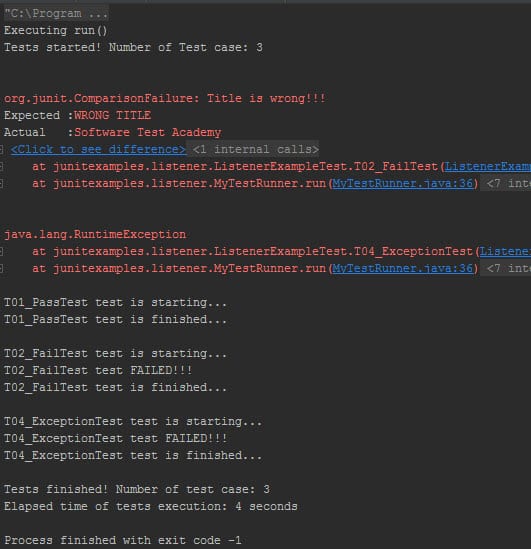How to use Junit Listener
JUnit Listeners
If you want to do some operations when your tests are started, passed, finished, failed, or skipped/ignored, you can use Listeners. Both JUnit and TestNG provide us Listeners, and in this article, I will explain how to add JUnit Listeners in your automation framework.
Listeners listen and handle events while your automation code is running. We can add a listener by creating a custom Runner. Then, we can use this custom runner in our test class with @RunWith annotation.
First, let’s write our Listener class by extending JUnit’s RunListener class and overriding its methods. I called our listener class as MyExecutionListener.
MyExecutionListener.java
package junitexamples.listener; /**
* Created by ONUR BASKIRT on 27.03.2016.
*/ import org.junit.Ignore;
import org.junit.runner.Description;
import org.junit.runner.Result;
import org.junit.runner.notification.Failure;
import org.junit.runner.notification.RunListener; import java.util.Date; public class MyExecutionListener extends RunListener { //Start and End time of the tests
long startTime;
long endTime; @Override
public void testRunStarted(Description description) throws Exception {
//Start time of the tests
startTime = new Date().getTime();
//Print the number of tests before the all tests execution.
System.out.println("Tests started! Number of Test case: " + description.testCount() + "\n");
} @Override
public void testRunFinished(Result result) throws Exception {
//End time of the tests
endTime = new Date().getTime();
//Print the below lines when all tests are finished.
System.out.println("Tests finished! Number of test case: " + result.getRunCount());
long elapsedSeconds = (endTime-startTime)/1000;
System.out.println("Elapsed time of tests execution: " + elapsedSeconds +" seconds");
} @Override
public void testStarted(Description description) throws Exception {
//Write the test name when it is started.
System.out.println(description.getMethodName() + " test is starting...");
} @Override
public void testFinished(Description description) throws Exception {
//Write the test name when it is finished.
System.out.println(description.getMethodName() + " test is finished...\n");
} @Override
public void testFailure(Failure failure) throws Exception {
//Write the test name when it is failed.
System.out.println(failure.getDescription().getMethodName() + " test FAILED!!!");
} //O.B: IntelliJ ignored by default. I did not succeed to run this method.
//If you know any way to accomplish this, please write a comment.
@Override
public void testIgnored(Description description) throws Exception {
super.testIgnored(description);
Ignore ignore = description.getAnnotation(Ignore.class);
String ignoreMessage = String.format(
"@Ignore test method '%s()': '%s'",
description.getMethodName(), ignore.value());
System.out.println(ignoreMessage + "\n");
}
}
Java
Second, we need to add the listener to the test execution. We can add the listener by calling the RunNotifier.addListener() method. This will register our JUnit Listener. I faced with a problem when I tried to use RunListener class’s testRunStarted method. Then, I found a solution that triggers this method after registering the listener in the run method. I wrote a comment about this solution in below code.
MyTestRunner.java
package junitexamples.listener; /**
* Created by ONUR BASKIRT on 27.03.2016.
*/ import org.junit.AssumptionViolatedException;
import org.junit.internal.runners.model.EachTestNotifier;
import org.junit.runner.notification.RunNotifier;
import org.junit.runner.notification.StoppedByUserException;
import org.junit.runners.BlockJUnit4ClassRunner;
import org.junit.runners.model.InitializationError;
import org.junit.runners.model.Statement; public class MyTestRunner extends BlockJUnit4ClassRunner { public MyTestRunner(Class<?> klass) throws InitializationError {
super(klass);
} @Override
public void run (RunNotifier notifier){
System.out.println("Executing run()");
//Add Listener. This will register our JUnit Listener.
notifier.addListener(new MyExecutionListener()); //Get each test notifier
EachTestNotifier testNotifier = new EachTestNotifier(notifier,
getDescription());
try {
//In order capture testRunStarted method
//at the very beginning of the test run, we will add below code.
//Invoke here the run testRunStarted() method
notifier.fireTestRunStarted(getDescription());
Statement statement = classBlock(notifier);
statement.evaluate();
} catch (AssumptionViolatedException e) {
testNotifier.fireTestIgnored();
} catch (StoppedByUserException e) {
throw e;
} catch (Throwable e) {
testNotifier.addFailure(e);
}
}
}
Java
Third, we need to write a test to verify our listener’s functionality. We register our custom runner with @RunWith(MyTestRunner.class) annotation and for alphabetic test execution, we add @FixMethodOrder(MethodSorters.NAME_ASCENDING) annotation.
Extra: Also, you can combine listeners with custom Retry Rule which described in other JUnit article. Thus, when your test fails, it will rerun the failed test according to given retry count.
ListenerExampleTest.java
package junitexamples.listener; import jdk.nashorn.internal.ir.annotations.Ignore;
import org.junit.BeforeClass;
import org.junit.FixMethodOrder;
import org.junit.Test;
import org.junit.runner.RunWith;
import org.junit.runners.MethodSorters;
import org.openqa.selenium.WebDriver;
import org.openqa.selenium.htmlunit.HtmlUnitDriver; import static org.hamcrest.CoreMatchers.is;
import static org.hamcrest.MatcherAssert.assertThat;
import static org.junit.Assert.assertEquals; /**
* Created by ONUR on 27.03.2016.
*/
@RunWith(MyTestRunner.class)
@FixMethodOrder(MethodSorters.NAME_ASCENDING)
public class ListenerExampleTest { static WebDriver driver;
final private static String URL = "http://www.swtestacademy.com"; @BeforeClass
public static void setupTest(){
driver = new HtmlUnitDriver();
driver.get(URL);
} /*
//If you want, you can add Retry Rule. (I explained it in another post.)
//Thus, when your test fails, it will rerun by given retry count.
@Rule
public RetryRule retryRule = new RetryRule(3);
*/ @Test
public void T01_PassTest() {
//Check title
assertThat(driver.getTitle(), is("Software Test Academy"));
} @Test
public void T02_FailTest() {
//Check title
assertEquals("Title is wrong!!!", "WRONG TITLE", driver.getTitle());
} //IntelliJ ignored by default
@Ignore
public void T03_IgnoreTest() {
//Check title is correct
assertThat(driver.getTitle(), is("Software Test Academy"));
} //Throw Exception
@Test
public void T04_ExceptionTest() {
throw new RuntimeException();
}
}
Java
Result:

How to use Junit Listener的更多相关文章
- WebDriver - 添加失败截图
WebDriver失败截图可以通过两种方式实现: 1. Use WebdriverEventListener 第一步:创建自己的WebDriverEventListener 创建自己的WebDrive ...
- 使用RunWith注解改变JUnit的默认执行类,并实现自已的Listener
使用RunWith注解改变JUnit的默认执行类,并实现自已的Listener在平时的单元测试,如果不使用RunWith注解,那么JUnit将会采用默认的执行类Suite执行,如下类: public ...
- Junit : how to add listener, and how to extends RunListener to override behaviors while failed
http://junit.sourceforge.net/javadoc/org/junit/runner/notification/RunListener.html org.junit.runner ...
- [Java] Spring + SpringMVC + Maven + JUnit 搭建
示例项目下载: https://github.com/yangyxd/SpringDemo 利用前面 SpringMVC 项目的配置方式,完成初步的项目创建.下面只讲一些不同之处. 传送门: [Jav ...
- How to Use JUnit With JMeter
Do you need to use JUnit in your testing processes? To answer this question, let's take a look first ...
- 监听器Listener
监听器 6个事件类,均以event结尾 *某些操作,如启动/关闭容器,创建/销毁会话,都将触发一种事件发生,当发生了某种事件,容器将创建对应的事件类对象 8个监听接口,均以Listener结尾 监听器 ...
- maven+springMVC+mybatis+junit详细搭建过程 ***
springMVC+mybatis框架搭建 在上一遍博客中以及讲诉了新建maven项目的流程,现在紧跟上一遍文章,接着搭建spring项目 首先我们先要弄清搭建项目的一般流程,需要注意哪些方面,想要什 ...
- 使用JUnit单元测试入门
一.JUnit是什么? JUnit是一个开发源代码的java测试框架,用于编写和运行可重复的测试.它是用于单元测试框架体系xUnit的一个实例(用于java语言).JUnit最初是由Erich Gam ...
- 获取JUnit的执行结果
junit执行之后会有一个结果展示,下面就来看一下怎么获取这些结果并将其存储为一个对象 junit代码如下: package test; import org.junit.After; import ...
随机推荐
- HTTP请求解析过程 (简单概括)
1.域名解析 用户输入网址,由域名系统DNS解析输入的网址: 2.TCP的3次握手 通过域名解析出的IP地址来向web服务器发起TCP连接请求,如果3次握手通过,则与web服务端建立了可靠的连接: 3 ...
- python3学习笔记之安装
一.Python安装 1.下载地址: https://www.python.org/downloads/release/python-365/ 2. Linux系统自带Python2.7,如需安装3 ...
- PHP面向对象构造和析构函数
一.构造函数 用来生成对象的函数 <?php class Ren{ public $name; public $sex;//性别是人一出生就知道的,可以用构造函数来定义 /*public fun ...
- MindMaster学习笔记
参考博客 http://blog.sina.com.cn/u/6406591976 作者名叫“MindMaster思维导图的博客 ”写了一系列关于思维导图的博客,可以去学习下. 1.其中有一篇比较详细 ...
- Springboot整合Mybatis 之分页插件使用
1: 引入jar包 <!-- 引入MyBatis分页插件--> <dependency> <groupId>com.github.pagehelper</gr ...
- Yii Listview
- python二 总结--函数-- 装饰器
装饰器是什么? 有什么用? 为什么要用? 真的有用吗? 1.装饰器: 装饰器: 定义:本质是函数,(装饰其他函数)就是为其他函数添加附加功能. 原则:1.不能修改被装饰的函数的源代码 ...
- make: *** /lib/modules/3.10.0-327.el7.x86_64/build: 没有那个文件或目录。 停止。
1.问题: [root@localhost]# make make -C /lib/modules/-.el7.x86_64/build M=/home/csri/poc/adore modules ...
- JustOj 2009: P1016 (dp)
题目描述 有一个箱子容量为v(正整数,o≤v≤20000),同时有n个物品(o≤n≤30),每个物品有一个体积 (正整数).要求从 n 个物品中,任取若干个装入箱内,使箱子的剩余空间为最小. ...
- python docopt模块详解
python docopt模块详解 docopt 本质上是在 Python 中引入了一种针对命令行参数的形式语言,在代码的最开头使用 """ ""&q ...
